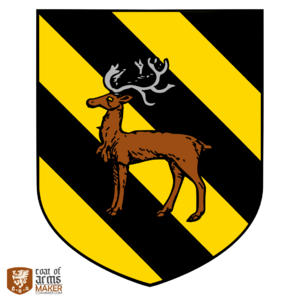House von Wettin: Difference between revisions
Drambenburg (talk | contribs) No edit summary |
Drambenburg (talk | contribs) |
||
| Line 52: | Line 52: | ||
===Establishment of House von Wettin=== | ===Establishment of House von Wettin=== | ||
Before the [[Fifty Years War (Iearth)|Fifty Years War]] there were many border skirmishes between the Averognese, the Mayottean Empire, and Drambenburg. In 1188, Karl Buchard, son of Duke Olfrik Buchard, was granted land on the border between the kingdom of Saxonie and the Mayottean Empire. Karl, being the seventh son of the duke, had no prospects to stay in Lerbin (then called Drambenburg) and took his family to the borderlands where he began construction on [[Anhalruit Castle]], using mostly forced labor from the indiginous peoples of the area. Construction of the castle was completed in 1197, and the king granted Karl the title of Markgraf, making Karl the first of a new house, which he dubbed "Wettin" because they were rulers over the Mark of Wettin. The city that was established around Anhalruit Castle became known as Wettinburgen, or the walled city of the Wettins. | Before the [[Fifty Years War (Iearth)|Fifty Years War]] there were many border skirmishes between the Averognese, the Mayottean Empire, and Drambenburg. In 1188, Karl Buchard, son of Duke Olfrik Buchard, was granted land on the border between the kingdom of Saxonie and the Mayottean Empire. Karl, being the seventh son of the duke, had no prospects to stay in Lerbin (then called Drambenburg) and took his family to the borderlands where he began construction on [[Anhalruit Castle (Drambenburg)|Anhalruit Castle]], using mostly forced labor from the indiginous peoples of the area. Construction of the castle was completed in 1197, and the king granted Karl the title of Markgraf, making Karl the first of a new house, which he dubbed "Wettin" because they were rulers over the Mark of Wettin. The city that was established around Anhalruit Castle became known as Wettinburgen, or the walled city of the Wettins. | ||
Since the introduction of the elective monarchy to the Holy Empire of Drambenburg, House von Wettin has supplied more Kaisers than any other great family. | Since the introduction of the elective monarchy to the Holy Empire of Drambenburg, House von Wettin has supplied more Kaisers than any other great family. | ||
Latest revision as of 14:22, 11 August 2022
| House von Wettin Haus von Wettin Wettin | |
|---|---|
Coat of Arms of the House of Wettin, depicting the von Wettin's family animal, the stag | |
| Parent family | Buchard |
| Country | Drambenburg |
| Current region | Wettinburgen province |
| Place of origin | Anhalruit, Drambenburg |
| Founded | 1197 |
| Founder | Karl I von Wettin |
| Current head | Peter XXI von Wettin |
| Titles | Prince or Princess of Wettinburgen |
| Style(s) | His or Her Grace |
| Motto | A Wettin Always Pays His Debts |
| Estate(s) | Anhalruit Castle |
| Cadet branches | Wettin-Strauseburg, Strauseburg-Cohlbridge, Anhalruit-Lerbin-Gotha |
The House of Wettin is one of the seven Great Families of Drambenburg, from the Drambenburgian province of Wettinburgen. Peter XXI von Wettin is the current head of the house and reigning Kaiser of Drambenburg. The house is ancient, existing since 1197 when Karl I von Wettin, the seventh son of Herzog Olfrik "Sturmmantel" Buchard, built the castle of Anhalruit in present-day Anhalruit, Wettenburgen, a Mark of the small kingdom of Saxonie, and was granted the title of Markgraf by the King in Lerbin. Ever since, the House of Wettin has been a protector of the realm.
Etymology
History
Establishment of House von Wettin
Before the Fifty Years War there were many border skirmishes between the Averognese, the Mayottean Empire, and Drambenburg. In 1188, Karl Buchard, son of Duke Olfrik Buchard, was granted land on the border between the kingdom of Saxonie and the Mayottean Empire. Karl, being the seventh son of the duke, had no prospects to stay in Lerbin (then called Drambenburg) and took his family to the borderlands where he began construction on Anhalruit Castle, using mostly forced labor from the indiginous peoples of the area. Construction of the castle was completed in 1197, and the king granted Karl the title of Markgraf, making Karl the first of a new house, which he dubbed "Wettin" because they were rulers over the Mark of Wettin. The city that was established around Anhalruit Castle became known as Wettinburgen, or the walled city of the Wettins.
Since the introduction of the elective monarchy to the Holy Empire of Drambenburg, House von Wettin has supplied more Kaisers than any other great family.
